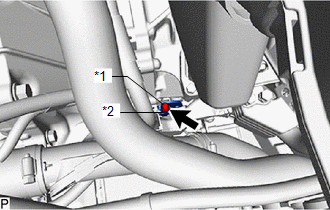Toyota Yaris: Clutch System / Bleeding
BLEEDING
CAUTION / NOTICE / HINT
NOTICE:
Wash off clutch fluid immediately if it comes in contact with any painted surface.
HINT:
- If any work is performed on the clutch system or if air in the clutch lines is suspected, bleed air from the clutch hydraulic system.
- In case of clutch fluid replacement, make sure that the old fluid is replaced in the clutch line between the reservoir and the bleeder before bleeding.
PROCEDURE
1. REMOVE CENTER COWL TOP VENTILATOR LOUVER
Click here

2. REMOVE BRAKE MASTER CYLINDER RESERVOIR FILLER CAP ASSEMBLY
Click here

3. FILL RESERVOIR WITH BRAKE FLUID
Click here

4. BLEED CLUTCH LINE
| (a) Remove the bleeder plug cap. |
|
(b) Connect a vinyl tube to the bleeder plug.
(c) Depress the clutch pedal 5 times, and then loosen the bleeder plug while the pedal is depressed.*1
(d) When fluid no longer comes out, tighten the bleeder plug, and then release the clutch pedal.*2
(e) Repeat steps *1 and *2 until all the air in the brake fluid is completely bled out.
NOTICE:
Add brake fluid to keep the level between the MIN and MAX lines of the reservoir while replacing the brake fluid.
(f) Check that all the air has been bled from the clutch line.
(g) Tighten the bleeder plug.
Torque:
8.4 N·m {86 kgf·cm, 74 in·lbf}
(h) Depress the clutch pedal 10 times or more and confirm its operation.
NOTICE:
This must be performed before the engine is started.
(i) Install the bleeder plug cap.
5. INSPECT FOR BRAKE FLUID LEAK
6. INSPECT BRAKE FLUID LEVEL IN RESERVOIR
Click here

7. INSTALL BRAKE MASTER CYLINDER RESERVOIR FILLER CAP ASSEMBLY
Click here

8. INSTALL CENTER COWL TOP VENTILATOR LOUVER
Click here

 Problem Symptoms Table
Problem Symptoms Table
PROBLEM SYMPTOMS TABLE HINT: Use the table below to help determine the cause of problem symptoms. If multiple suspected areas are listed, the potential causes of the symptoms are listed in order of probability in the "Suspected Area" column of the table...
 Clutch Unit
Clutch Unit
..
Other information:
Toyota Yaris XP210 (2020-2025) Owner's Manual: Receiving an Incoming Call
When an incoming call is received, the incoming call notification screen is displayed. The “Incoming Call Notifications” setting must be on. Refer to Communication Settings. To accept the call, press the pick-up button on the audio control switch or select on the screen...
Toyota Yaris XP210 (2020-2025) Owner's Manual: Picture Quality Adjustment
Picture quality adjustment can be done while the shift lever is in reverse (R). There are four settings which can be adjusted including, brightness, contrast, tint, and color. When adjusting, pay sufficient attention to the vehicle surroundings...
Categories
- Manuals Home
- Toyota Yaris Owners Manual
- Toyota Yaris Service Manual
- Fuel Gauge
- How to connect USB port/Auxiliary jack
- Opening and Closing the Liftgate/Trunk Lid
- New on site
- Most important about car
Front Seat Belt Pretensioners
The front seat belt pretensioners are designed to deploy in moderate or severe frontal, near frontal collisions.
In addition, the pretensioners operate when a side collision or a rollover accident is detected. The pretensioners operate differently depending on what types of air bags are equipped. For more details about the seat belt pretensioner operation, refer to the SRS Air Bag Deployment Criteria.

